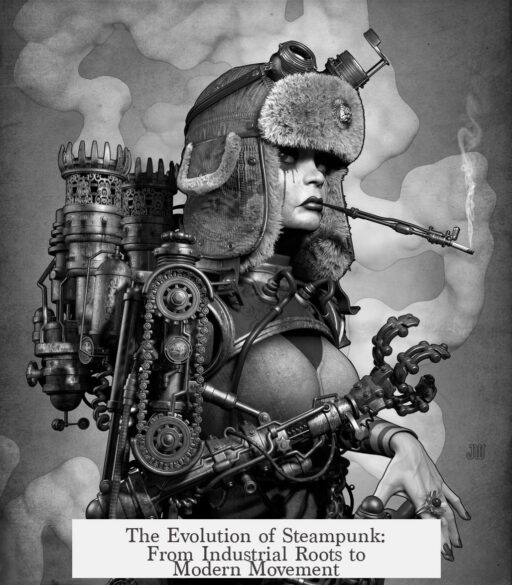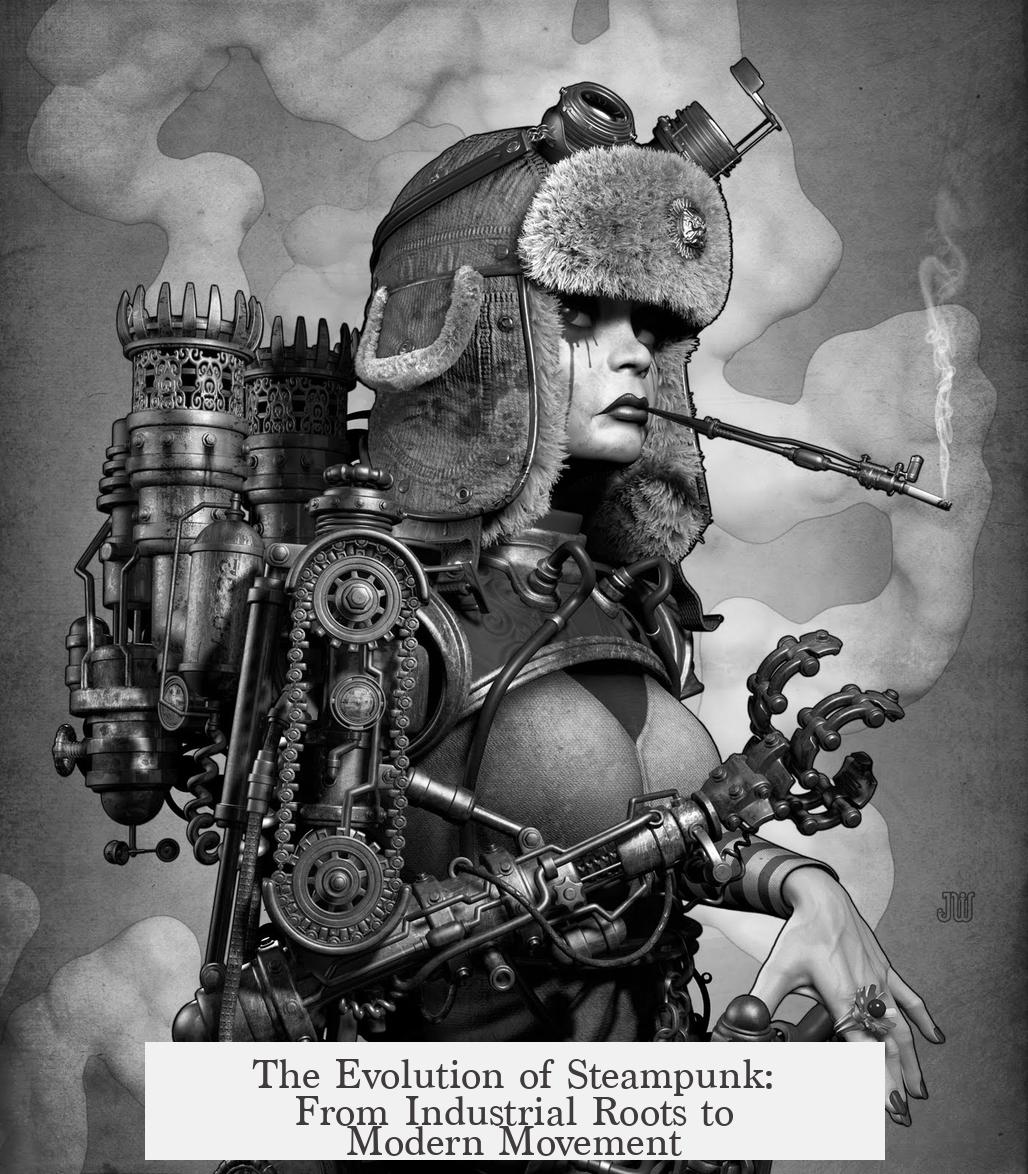Steampunk evolves from the 19th-century Industrial Revolution through early science fiction, morphing into a distinct genre by the late 20th century with a mix of Victorian aesthetics and punk attitude. It blends historical technology with speculative fiction, reflecting cultural and technological attitudes.
The Industrial Revolution drives the initial backdrop for steampunk. Rapid technological progress reshapes transportation and communications. Steamships, railways, early automobiles, and experiments in powered flight emerge. Meanwhile, new uses of electricity appear in lighting, telegraphy, and telephony, signaling a transformation in daily life. This era fuels imagination about technology and society’s future.
Early science fiction often explores hypothetical inventions typical of this period. Writers like Jules Verne create stories around submarines and underground journeys. Hugo Gernsback’s gadgets envision future inventions but do not yet connect to the steampunk identity. The term “steampunk” is not yet coined, so these works stand as scientific fantasy or proto-science fiction.
The 1980s introduce cyberpunk, a genre known for its “punk” attitude—rebellion and DIY ethos applied to science fiction. Cyberpunk authors, including William Gibson and Bruce Sterling, depict near-future dystopias featuring cybernetic enhancements, sprawling computer networks, and corporate control. The gritty, lived-in settings contrast sharply with earlier gleaming futuristic visions.
Steampunk officially takes shape with Gibson and Sterling’s 1990 novel The Difference Engine. It reimagines Victorian England with advanced, rudimentary computers known as difference engines. This alternate history combines Victorian aesthetics with cyberpunk’s technological grit and questioning attitude. The resulting narrative focuses on technology’s social impact from a retro-futuristic viewpoint.
The term “steampunk” itself is coined in 1987 by author K.W. Jeter. He seeks a collective name for works by himself and others blending Victorian themes with speculative technology. The word riffs on “cyberpunk” but grounds the genre firmly in 19th-century industrial motifs powered by steam instead of digital tech.
Since then, steampunk grows far beyond literature. It becomes a cultural and artistic movement that involves fashion, art, design, and philosophy. Collections like Steaming into a Victorian Future: A Steampunk Anthology examine the genre’s role in reimagining history. These essays explore how steampunk interrogates cultural memory and contemporary norms by imagining “what could have been” under different technological paths.
Similarly, Brandy Schillace’s Clockwork Futures analyses how steampunk explores technology’s impact in fiction and culture. The book tracks the shifting depiction of engineers and technology heroes over two centuries, noting ambivalence about progress even during optimism-filled pulp stories. It highlights how scientific concepts, such as fluidic computing, rarely appear because they do not align with steampunk’s ideological lens.
Steampunk Prime, edited by Mike Ashley, offers another angle. It features speculative fiction published between 1880 and 1914, revealing Victorian visions of the future. Surprisingly, these often focus more on electricity than steam. Themes like instant communication’s social effects and early thoughts on genetic engineering and artificial intelligence emerge—showing complex technological anxieties that echo into the present.
| Key Phase | Features | Significant Works/People |
|---|---|---|
| Industrial Revolution | Technological transformation, steam power, early electricity | Jules Verne novels Twenty Thousand Leagues Under the Sea |
| Early Science Fiction | Imagined inventions, gadgetry, proto-steampunk ideas | Hugo Gernsback’s Ralph 124C 41+ |
| Cyberpunk Emergence | Punk attitude, dystopian tech futures, cyberspace | William Gibson’s Neuromancer, Bruce Sterling |
| Steampunk Birth | Victorian alternate history, technology as social force | The Difference Engine by Gibson & Sterling, K.W. Jeter |
| Steampunk Expansion | Culture, art, literature, reimagined history | Steaming into a Victorian Future, Clockwork Futures |
| Historical Speculative Fiction | Victorian futurism focusing on electricity & social change | Steampunk Prime anthology |
Steampunk reflects ongoing cultural dialogues about technology and society. It poses questions around progress, modernity, and historical memory. By blending history with invention, it creates an imaginative playground to explore alternative possibilities.
- The Industrial Revolution fuels early technological themes central to steampunk.
- Cyberpunk inspires steampunk’s rebellious attitude and critical stance on technology.
- The Difference Engine is foundational as the first novel to blend Victorian settings with speculative technology.
- Steampunk grows into a broader cultural movement questioning the implications of technological change.
- Victorian speculative fiction reveals early anxieties about electricity and social transformation, informing modern steampunk perspectives.
Can Someone Explain to Me the Evolution of Steampunk?
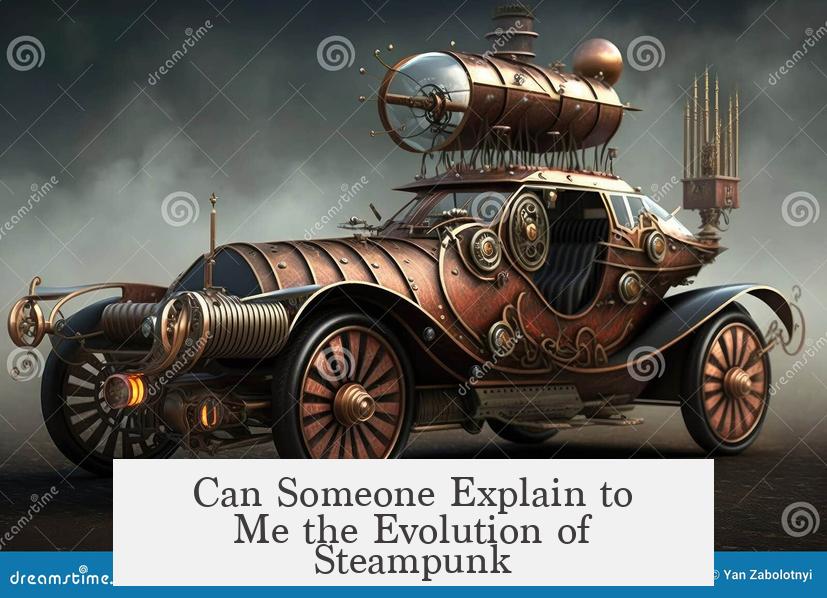
Steampunk evolves from the Industrial Revolution’s imagination of technology and society, blending Victorian-era aesthetics with speculative inventions powered by steam and clockwork technology. This fascinating genre grew from early science fiction, weathered the storm of cyberpunk, and finally blossomed in the late 20th century into its own unique, cultural phenomenon.
But how did steampunk become what it is today? Let’s pull on our goggles, adjust our top hats, and take a journey through its intriguing evolution.
The Genesis of Steampunk: A Gear Turns in the Industrial Era
The 19th century industrial revolution transformed society by turbocharging technology. Steamships chugged along rivers, railroads cut across continents, and inventors experimented with early automobiles and flights. This era gave people new ways to live, work, and imagine.
Electricity buzzed into existence with telegraphs and telephones spreading voice and information faster than ever before.
All of this technology sparked early science fiction writers like Jules Verne. His novels Journey to the Center of the Earth and Twenty Thousand Leagues Under the Sea took readers on grand adventures filled with imaginative inventions, but steampunk as a term hadn’t surfaced yet. It was just plain old science fiction with gears and steam.
Cyberpunk: The Rebel Predecessor to Steampunk
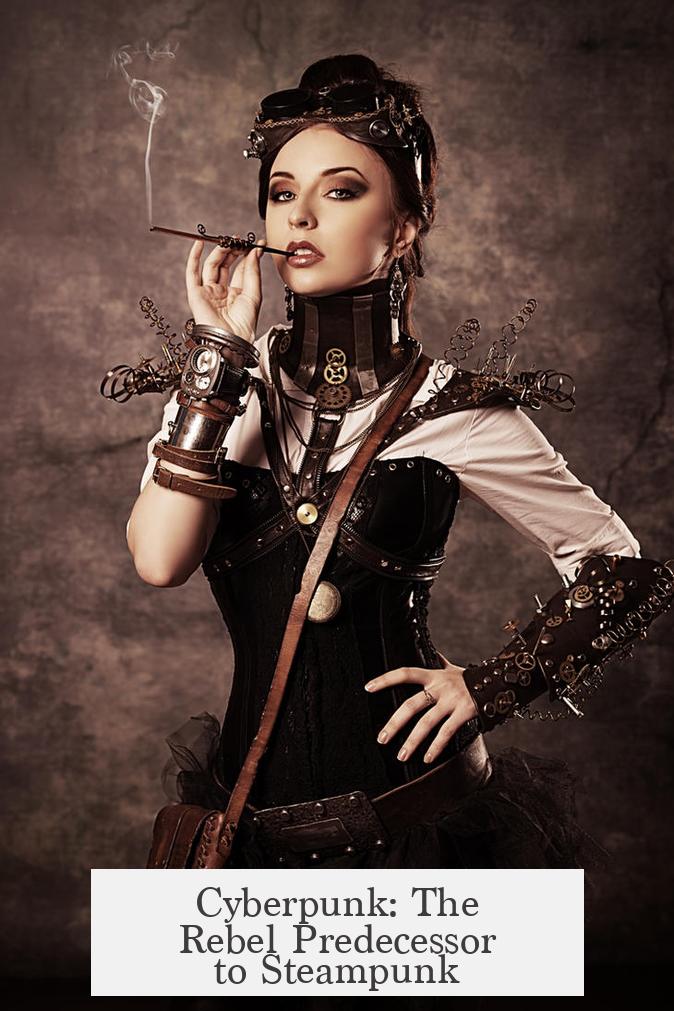
Fast forward to the 1980s, and the literary scene welcomes a new punk: cyberpunk. This genre blends a gritty, rebellious attitude with near-future dystopias full of cybernetic enhancements and sprawling digital networks.
Writers like William Gibson and Bruce Sterling created stories of alienated humans plugged into virtual realities and shadowy corporations controlling the world. Movies like Blade Runner visualized this grimy, neon-lit future — a stark contrast to shiny, optimistic Golden Age sci-fi.
The “punk” in cyberpunk symbolizes a do-it-yourself, anti-establishment vibe. This attitude laid the foundation for steampunk’s later anti-mainstream aesthetic, though cyberpunk’s setting was high-tech and futuristic, not Victorian.
The Birth of Steampunk: Victorian Tech Meets Cyberpunk Spirit
Steampunk was born when these two worlds collided. In 1990, Gibson and Sterling collaborated on The Difference Engine, a novel set in an alternate Victorian era. Here, the computer isn’t digital; it’s mechanical—think gears and steam-powered calculating machines.
This book imagines a reality where Victorians wholeheartedly embraced emerging technologies, creating a unique blend of history and speculative science. The world remained gritty and complex, much like cyberpunk, but with a nostalgic twist.
The actual term “steampunk” was coined in 1987 by writer K. W. Jeter, who looked for a fitting name to describe fiction that riffed off cyberpunk but used Victorian-era technology and aesthetics. He predicted these Victorian fantasies would be the “next big thing.” Spoiler alert: he was right.
Steampunk’s Broader Exploration: Beyond Just Gears and Goggles
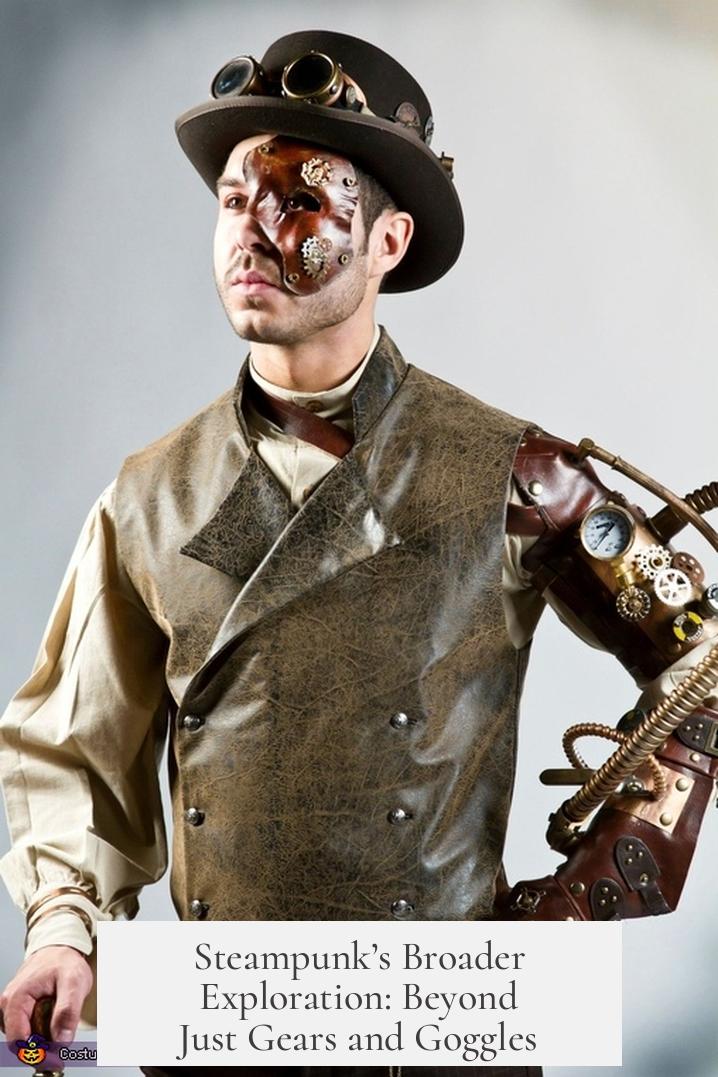
Steampunk didn’t just stay a literary curiosity; it expanded into many creative and intellectual arenas.
Steaming into a Victorian Future: A Steampunk Anthology, edited by Taddeo and Miller, offers a deep dive into how steampunk isn’t mere escapism. Instead, it serves as an ideological lens to question cultural norms and technology’s role in society. Revisiting the “never-was” Victorian past asks us what we value about progress, culture, and identity today.
Brandy Schillace’s Clockwork Futures takes this a step further by examining scientists and engineers’ roles in fiction over two centuries. She highlights how early 20th-century pulp heroes showed mixed feelings about technological progress. Some ideas, like fluidic computing, don’t appear in steampunk because they challenge how we view technology’s history and evolution.
Finally, Steampunk Prime collects speculative fiction originally published between 1880 and 1914. This collection reveals fascinating thoughts from the era’s writers about the future — notably, these stories often feature electricity more than steam, imagining instant communication changing social bonds, and even hinting at genetic engineering and artificial intelligence. Talk about Victorian visionaries!
Why Should You Care About Steampunk’s Evolution?
Steampunk isn’t just a quirky costume style or a niche book genre. It offers a way to rethink how communities interact with technology and history. The genre urges us to reflect on measurement of progress. Does new always mean better? What is lost as we race forward?
Steampunk invites creativity and critical thinking. It blends imagination with history. It challenges us to create alternative futures by reimagining the past. Plus, it shows us that history is not fixed — it’s a playground ripe for stories, art, inventions, and social critique.
Want to Dive Into Steampunk? Here Are Some Tips
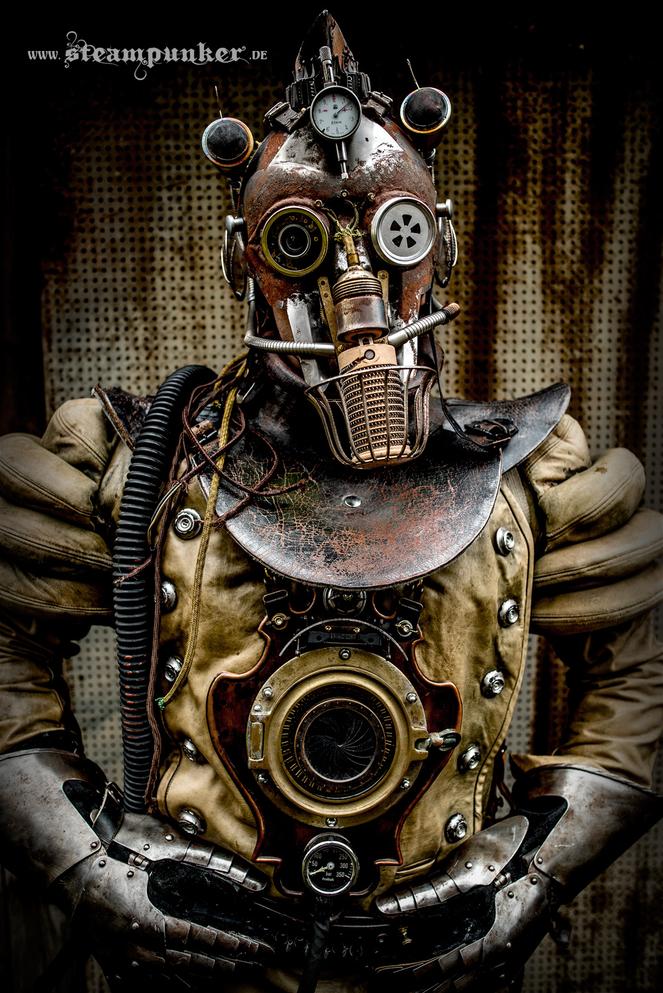
- Start by reading The Difference Engine to grasp classic steampunk storytelling.
- Explore the original Victorian speculative fiction in Steampunk Prime for authentic period perspectives.
- Check out academic essays like those in Steaming into a Victorian Future to understand the cultural significance.
- Join steampunk conventions or online communities to see the creativity in action—costumes, gadgets, and stories!
- Think about how you could reimagine current technology in a Victorian context. What clocks and cogs would replace microchips?
Steampunk’s journey is a testament to the endless human capacity for reinvention—both of technology and culture. It builds upon old ideas, remixes them, and produces something engaging, thought-provoking, and imaginative.
Final Thoughts: Steam, Punk, and More Than Nostalgia
Steampunk’s evolution is not linear or confined to a single medium. It bridges literature, history, art, and philosophy while keeping a mischievous, punk spirit alive. It asks how technology shapes society and how society shapes technology in return.
What if the future wasn’t sleek and digital but intricate and mechanical? What might we learn from that? Steampunk answers with a cheerful, gear-grinding “Let’s find out!”
So next time someone asks, “Can someone explain the evolution of steampunk?” you’re ready to take them on a whirlwind tour—from the Industrial Revolution’s smoke and steam, through cyberpunk’s neon glow, to a Victorian alternative future rich with possibility.
What historical factors led to the rise of Steampunk?
Steampunk evolved from the Industrial Revolution’s rapid tech development in the 19th century. Advances in steam engines, transportation, and early electricity shaped the setting Steampunk imagines—an alternate Victorian era where these technologies are dominant.
How did early science fiction influence Steampunk?
Early science fiction like Jules Verne’s novels featured fantastic inventions and new tech. Though not called Steampunk then, these stories laid the groundwork by focusing on gadgets and Victorian-era scientific ideas, inspiring later Steampunk themes.
What role did cyberpunk play in creating Steampunk?
Steampunk borrowed the rebellious, DIY attitude from 1980s cyberpunk. When Gibson and Sterling set a cyberpunk-style story in the Victorian era in The Difference Engine, it gave Steampunk its core aesthetic and attitude.
Who coined the term “Steampunk” and when?
The term “Steampunk” was coined in 1987 by writer K. W. Jeter. He created the name as a playful riff on cyberpunk, to describe the emerging genre that focused on Victorian technology and settings.
How has Steampunk been explored beyond literature?
Steampunk has grown to include academic studies and cultural critiques. Books and anthologies examine how it questions historical and cultural norms, looking at technology’s role and imagining alternative pasts that challenge present ideas.
